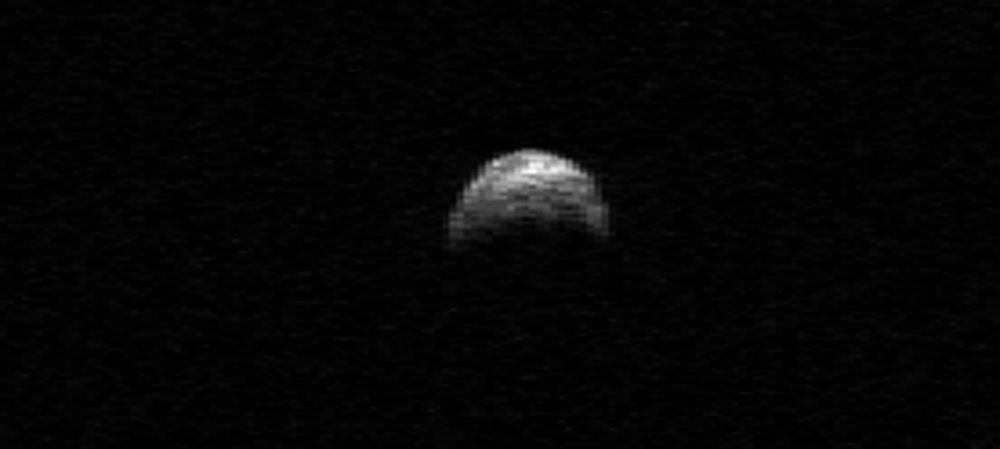Giant Asteroid 2005 YU55 Comes Closer to Earth Than Moon Next Week

A huge asteroid about the size of an aircraft carrier will zoom past our planet next week, flying between the Earth and the orbit of the moon when it flies by on Tuesday (Nov. 8).
The space rock, called asteroid 2005 YU55, poses no threat to the Earth but will be observed by excited astronomers around the world. It's about 1,300 feet (400 meters) wide, round and blacker than coal, NASA scientists said.
At its closest point, asteroid 2005 YU55 will pass Earth at a range of about 201,700 miles (324,600 kilometers on Tuesday at 6:28 p.m. EST (2328 GMT). The average distance between the moon and Earth is about 238,854 miles (384,399 km).
"This is particularly exiting since it is the first time since 1976 that an object of this size has passed this closely to the Earth," said Scott Fisher, a program director of the NSF's Division of Astronomical Sciences, in an NSF webchat Thursday (Nov. 3) organized by ScienceNow. "It gives us a great (and rare!) chance to study a near-Earth object like this. In fact, we have several telescopes set up and ready to observe this event already."
Those telescopes include the giant Arecibo radio telescope in Puerto Rico and several NASA Deep Space Network instruments, to name a few.
Astronomers plan to use the telescopes to snap radar images of asteroid 2005 YU55 similar to one taken by the Arecibo observatory in April 2010, when the space rock flew within 1.5 million miles (2.4 million km) of Earth. Tuesday's flyby, however, is much closer and should allow astronomers to snap more detailed images of the asteroid. [Photos: Asteroids in Deep Space]
Observatories in Hawaii will also attempt to take spectroscopic measurements of the asteroid to analyze its composition, researchers said.
Get the Space.com Newsletter
Breaking space news, the latest updates on rocket launches, skywatching events and more!
Like its name suggests, asteroid 2005 YU55 was discovered in 2005 and orbits the sun in an elliptical path that extends from inside the orbit of Venus out to just outside the orbit of Mars, scientists said. The asteroid completes one trip around the sun every 15 months.
One observatory that will not be watching the asteroid is NASA's Hubble Space Telescope, but only because of the asteroid's speed.
"Thousands of amateur and professional astronomers will observe this object near its closest approach to Earth. However, it is moving too fast on the sky for Hubble to observe it," said Don Yeomans, manager of NASA's Near-Earth Object Office at the Jet Propulsion Laboratory in Pasadena, Calif.
The asteroid will pose a challenge for amateur astronomers because it will be faint and fast-moving. A small telescope with a mirror no smaller than 6 inches (15 centimeters) is required to try and spot it, NASA officials said.
The asteroid's coordinates for any given time are available at the JPL Solar System Dynamics website, here: http://ssd.jpl.nasa.gov/.
Yeomans, Fisher and other astronomers have stressed that the public should not be concerned about asteroid 2005 YU55 impacting Earth or causing any kind of gravitational effects on our planet during the flyby. The space rock is much too small to influence life on Earth from its position in space and its chances of actually hitting the planet are nil.
"There is no reason to worry about YU55 getting caught up in the gravity of the Earth," Fisher said. "Through our observations of the object, we know that there is NO chance of it impacting either the Earth or the moon for at least the next 100 years."
If you snap a photo of asteroid 2005 YU55 during its Nov. 8 flyby of Earth and would like to share it with SPACE.com, send the image and your observing comments to SPACE.com managing editor Tariq Malik at tmalik@space.com.
You can follow SPACE.com Managing Editor Tariq Malik on Twitter @tariqjmalik. Follow SPACE.com for the latest in space science and exploration news on Twitter @Spacedotcom and on Facebook.
Join our Space Forums to keep talking space on the latest missions, night sky and more! And if you have a news tip, correction or comment, let us know at: community@space.com.

Tariq is the Editor-in-Chief of Space.com and joined the team in 2001, first as an intern and staff writer, and later as an editor. He covers human spaceflight, exploration and space science, as well as skywatching and entertainment. He became Space.com's Managing Editor in 2009 and Editor-in-Chief in 2019. Before joining Space.com, Tariq was a staff reporter for The Los Angeles Times covering education and city beats in La Habra, Fullerton and Huntington Beach. In October 2022, Tariq received the Harry Kolcum Award for excellence in space reporting from the National Space Club Florida Committee. He is also an Eagle Scout (yes, he has the Space Exploration merit badge) and went to Space Camp four times as a kid and a fifth time as an adult. He has journalism degrees from the University of Southern California and New York University. You can find Tariq at Space.com and as the co-host to the This Week In Space podcast with space historian Rod Pyle on the TWiT network. To see his latest project, you can follow Tariq on Twitter @tariqjmalik.











